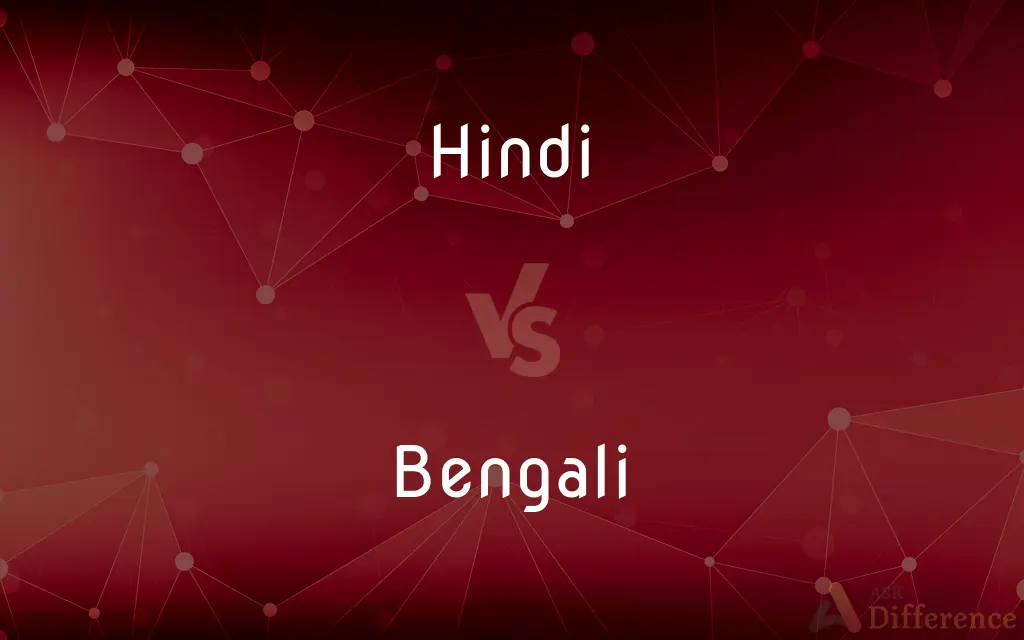Hindi vs. Bengali — What's the Difference?
By Fiza Rafique & Maham Liaqat — Updated on March 24, 2024
Hindi is an Indo-Aryan language primarily spoken in India, serving as its official language, while Bengali, also an Indo-Aryan language, is the primary language of Bangladesh and the second most spoken language in India.

Difference Between Hindi and Bengali
Table of Contents
ADVERTISEMENT
Key Differences
Hindi, written in the Devanagari script, is one of the most widely spoken languages in India and serves as one of the country's official languages. It has a rich literary tradition that spans centuries, including classical poetry, novels, and modern works. Whereas Bengali, written in the Bengali script, is the official language of Bangladesh and also widely spoken in the Indian states of West Bengal, Tripura, and Assam. Bengali has a prestigious literary heritage, being the language of the Nobel laureate Rabindranath Tagore.
While Hindi vocabulary is heavily influenced by Sanskrit, incorporating Sanskrit-derived terms and using Sanskrit rules for compounding and grammar, Bengali vocabulary also includes a significant number of Sanskrit words but tends to preserve more of the original Sanskrit pronunciation. On the other hand, Bengali has also absorbed numerous words from Persian, Arabic, and English, reflecting the historical interactions of the Bengal region with various cultures.
Hindi and Bengali both follow the Subject-Object-Verb (SOV) order in their syntax, but there are differences in their use of postpositions and cases. Hindi grammar includes a system of gender for nouns and adjectives, affecting verb conjugation, while Bengali grammar distinguishes between gender in the third person singular but not in verb conjugation, making it somewhat simpler in this aspect.
Hindi has a distinction between aspirated and unaspirated consonants, a feature it shares with Bengali. However, Bengali has a unique set of vowel sounds and nasalized vowels that differ from those in Hindi. This leads to a distinctive sound system that sets the languages apart.
The cultural contexts in which Hindi and Bengali are used also differ significantly. Hindi has a broad presence in Indian media, including Bollywood, national news, and music, giving it a wide-reaching influence. Bengali, with its rich tradition of literature, music, and cinema, plays a crucial role in the cultural identity of Bengali-speaking people, emphasizing the depth of its literary and artistic traditions.
ADVERTISEMENT
Comparison Chart
Script
Devanagari
Bengali
Geographic Distribution
Primarily in northern and central India
Bangladesh and eastern India (West Bengal, Tripura, Assam)
Literary Tradition
Rich, with influences from Sanskrit
Prestigious, with notable contributions from Nobel laureate Rabindranath Tagore
Vocabulary Influence
Sanskrit, Persian, Arabic, English
Sanskrit, Persian, Arabic, English, with a significant influence from local dialects
Grammar
Gender system affects verb conjugation
Gender distinction in third person singular but not in verb conjugation
Phonology
Distinction between aspirated and unaspirated consonants
Unique vowel sounds and nasalized vowels
Cultural Presence
Extensive in Indian media and Bollywood
Strong in literature, music, and regional cinema
Syntax
Subject-Object-Verb (SOV) order
Subject-Object-Verb (SOV) order, with specific postpositions and cases
Compare with Definitions
Hindi
An Indo-Aryan language with a rich literary tradition.
Hindi poetry encompasses everything from romantic verses to philosophical musings.
Bengali
Has a rich tradition of literature and arts.
Rabindranath Tagore, a Bengali poet, won the Nobel Prize in Literature.
Hindi
The official language of India, spoken by millions.
Hindi is taught in schools throughout India.
Bengali
The official language of Bangladesh and a major language in India.
Bengali is celebrated for its contribution to literature and music.
Hindi
Characterized by a significant Sanskrit influence.
Many Hindi words are derived from Sanskrit.
Bengali
Written in the Bengali script, known for its distinctive letters.
The Bengali script is beautiful and complex.
Hindi
Uses the Devanagari script for writing.
Learning the Devanagari script is essential for reading Hindi literature.
Bengali
Incorporates words from Sanskrit, Persian, and English.
Bengali language has absorbed many loanwords through its history.
Hindi
A key language in Indian media and Bollywood.
Hindi films are enjoyed by audiences worldwide.
Bengali
Plays a significant role in the cultural identity of Bengali people.
Bengali cinema is a major part of India's regional filmmaking.
Hindi
Hindi (Devanagari: हिन्दी, IAST/ISO 15919: Hindī), or more precisely Modern Standard Hindi (Devanagari: मानक हिन्दी, IAST/ISO 15919: Mānak Hindī), is an Indo-Aryan language spoken chiefly in India. Hindi has been described as a standardised and Sanskritised register of the Hindustani language, which itself is based primarily on the Khariboli dialect of Delhi and neighbouring areas of Northern India.
Bengali
Of or relating to Bengal or its people, language, or culture.
Hindi
An Indic language of northern India, derived from Sanskrit and written in the Devanagari script. It is the fourth most widely spoken language in the world, with more than 250 million people speaking it as their first language.
Bengali
A native or inhabitant of Bengal.
Hindi
Relating to Hindi.
Bengali
A person of Bengali ancestry.
Hindi
A group of vernacular Indic dialects spoken in northern India.
Bengali
The modern Indic language of Bangladesh and West Bengal, a state of eastern India.
Hindi
The literary and official language of northern India that is based on these dialects. It is written in Devanagari and uses Sanskrit as a resource language.
Bengali
Of or pertaining to the Bengali language; as, Bengali poetry.
Hindi
The name given by Europeans to that form of the Hindustani language which is chiefly spoken by native Hindus. In employs the Devanagari character, in which Sanskrit is written.
Bengali
Of, pertaining to, or characteristic of Bangladesh (formerly Bengal) or its inhabitants; as, Bengali hills.
Hindi
The most widely spoken of modern Indic vernaculars; spoken mostly in the north of India; along with English it is the official language of India; usually written in Devanagari script
Bengali
(Hinduism) a member of a people living in Bangladesh and West Bengal (mainly Hindus)
Hindi
Of or relating to or supporting Hinduism;
The Hindu faith
Bengali
An ethnic group speaking Bengali and living in Bangladesh and eastern India
Bengali
A Magadhan language spoken by the Bengali people; the official language of Bangladesh and Bengal
Bengali
Of or relating to or characteristic of Bengal or its people;
Bengali hills
Common Curiosities
What is the main difference between Hindi and Bengali?
The main difference lies in their script, phonology, and the regions where they are predominantly spoken.
Is Bengali influenced by other languages?
Yes, Bengali has absorbed words from Sanskrit, Persian, Arabic, and English.
How are Hindi and Bengali written?
Hindi is written in the Devanagari script, while Bengali is written in the Bengali script.
How do the cultural contexts of Hindi and Bengali differ?
Hindi has a broad cultural presence across India, especially in Bollywood, while Bengali culture is renowned for its literary and artistic heritage.
What is the historical significance of Bengali?
Bengali has a rich history, especially in the context of the Bengali Renaissance and the Bangladesh Liberation War.
Are Hindi and Bengali mutually intelligible?
No, due to significant differences in vocabulary, pronunciation, and grammar, they are not mutually intelligible.
Which language has a greater influence on literature?
Both have made significant contributions, but Bengali is particularly noted for its Nobel Prize-winning literature.
Can speakers of Hindi easily learn Bengali, and vice versa?
Learning the other language might be easier due to some grammatical and lexical similarities but requires dedicated study due to differences in script and pronunciation.
What role do Hindi and Bengali play in education in their respective regions?
Both are taught as first languages in schools in their respective regions and as second languages in other parts of India.
What is the significance of Hindi in Indian cinema?
Hindi is the predominant language of Bollywood, India's largest film industry, making it influential both nationally and internationally.
Are there any similarities between Hindi and Bengali?
Yes, both languages share the Indo-Aryan root, follow the SOV syntax, and have a significant number of Sanskrit-derived words.
What are the key challenges in learning Hindi for Bengali speakers, and vice versa?
Key challenges include mastering a new script, pronunciation differences, and the distinct grammatical features of each language.
How has Sanskrit influenced Hindi and Bengali?
Sanskrit has heavily influenced the vocabulary, grammatical structure, and literary traditions of both languages.
Share Your Discovery

Previous Comparison
Uvula vs. Epiglottis
Next Comparison
Chicken vs. HorseAuthor Spotlight
Written by
Fiza RafiqueFiza Rafique is a skilled content writer at AskDifference.com, where she meticulously refines and enhances written pieces. Drawing from her vast editorial expertise, Fiza ensures clarity, accuracy, and precision in every article. Passionate about language, she continually seeks to elevate the quality of content for readers worldwide.
Co-written by
Maham Liaqat














































